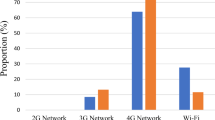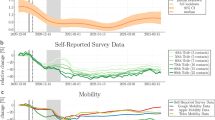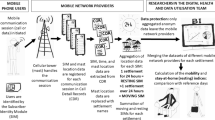Abstract
There is ongoing concern that extended exposure to cell phone electromagnetic radiation could be related to an increased risk of negative health effects. Epidemiological studies seek to assess this risk, usually relying on participants’ recalled use, but recall is notoriously poor. Our objectives were primarily to produce a forecast method, for use by such studies, to reduce estimation bias in the recalled extent of cell phone use. The method we developed, using Bayes’ rule, is modelled with data we collected in a cross-sectional cluster survey exploring cell phone user-habits among New Zealand adolescents. Participants recalled their recent extent of SMS-texting and retrieved from their provider the current month's actual use-to-date. Actual use was taken as the gold standard in the analyses. Estimation bias arose from a large random error, as observed in all cell phone validation studies. We demonstrate that this seriously exaggerates upper-end forecasts of use when used in regression models. This means that calculations using a regression model will lead to underestimation of heavy-users’ relative risk. Our Bayesian method substantially reduces estimation bias. In cases where other studies’ data conforms to our method's requirements, application should reduce estimation bias, leading to a more accurate relative risk calculation for mid-to-heavy users.
This is a preview of subscription content, access via your institution
Access options
Subscribe to this journal
Receive 6 print issues and online access
$259.00 per year
only $43.17 per issue
Buy this article
- Purchase on Springer Link
- Instant access to full article PDF
Prices may be subject to local taxes which are calculated during checkout





Similar content being viewed by others
References
Mediamark Research & Intelligence. Kids Intelligence: Kids’ Cell Phone Ownership Has Dramatically Increased in Past Five Years. Mediamark Research & Intelligence, New York, 2010.
World Health Organisation. WHO Research Agenda for Radiofrequency Fields. WHO, Geneva, 2010.
Cardis E., Richardson L., Deltour I., Armstrong B., Feychting M., and Johansen C., et al. Brain tumour risk in relation to mobile telephone use: results of the INTERPHONE international case-control study. Int J Epidemiol 2010: 39: 675–694.
Christensen H.C., Schuz J., Kosteljanetz M., Skovgaard Poulsen H., Boice J.C., and McLaughlin J.K., et al. Cellular telephones and risk for brain tumors: a population-based, incident case-control study. Neurology 2005: 64: 1189–1195.
Hardell L., Carlberg M., and Hansson Mild K. Use of cellular telephones and brain tumour risk in urban and rural areas. Occup Environ Med 2005: 62: 390–394.
Hardell L., Carlberg M., Soderqvist F., Mild K.H., and Morgan L.L. Long-term use of cellular phones and brain tumours: increased risk associated with use for > or =10 years. Occup Environ Med 2007: 64: 626–632.
Hepworth S.J., Schoemaker M.J., Muir K.R., Swerdlow A.J., and van Tongeren M.J., et al. Mobile phone use and risk of glioma in adults: case-control study. BMJ 2006: 332: 883–887.
Lahkola A., Salminen T., Raitanen J., Heinavaara S., and Schoemaker M.J., et al. Meningioma and mobile phone use: a collaborative case-control study in five North European countries. Int J Epidemiol 2008: 37: 1304–1313.
Parslow R.C., Hepworth S.J., and McKinney P.A. Recall of past use of mobile phone handsets. Rad Prot Dos 2003: 106: 233–240.
Vrijheid M., Armstrong B., Bedard D., Brown J., and Deltour I., et al. Recall bias in the assessment of exposure to mobile phones. J Expo Sci Env Epid 2009: 19: 369–381.
Vrijheid M., Cardis E., Armstrong B.K., Auvinen A., and Berg G., et al. Validation of short term recall of mobile phone use for the Interphone study. Occup Environ Med 2006a: 63: 237–243.
Aydin D., Feychting M.J.S., Andersen T.V., Poulsen A.H., Prochazka M., and Klaeboe L., et al. Impact of random and systematic recall errors and of selection bias in case-control studies on mobile phone use and brain tumours in adolescents (CEFALO study). Bioelectromagnetics 2011a: 32: 396–407.
Inyang I., Benke G., Morrissey J.J., McKenzie R.J., and Abramson M. How well do adolescents recall use of mobile telephones? Results of a validation study. BMC Med Res Methodol 2009: 9: 36–45.
Vrijheid M., Deltour I., Krewski D., Sanchez M., and Cardis E. The effects of recall errors and of selection bias in epidemiologic studies of mobile phone use and cancer risk. J Expo Sci Env Epid 2006b: 16: 371–384.
Bland M., and Altman D. Measuring agreement in method comparison studies. Stat Method Med Res 1999: 8: 135–160.
Izard V., and Dehaene S. Calibrating the mental number line. Cognition 2008: 106: 1221–1247.
Jones G. Inverse regression from longitudinal data. 2010 JSM Proceedings, Biometrics Section. American Statistical Association, Alexandria, VA, 2008.
Thomas D.C., Witte J.S., and Greenland S. Dissecting effects of complex mixtures: who's afraid of informative priors? Epidemiology 2007: 18: 186–190.
Jarque C.M., and Bera A.K. A test for normality of observations and regression residuals. Int Stat Rev 1987: 55: 163–172.
Brannon E.M. The representation of numerical magnitude. Cogn Neurosci 2006: 16: 222–229.
Krueger L.E. Perceived numerosity: a comparison of magnitude production, magnitude estimation, and discrimination judgments. Percept Psychophys 1984: 35: 536–542.
Dillman D.A. Mail and Internet Surveys. John Wiley & Sons, Inc., NY, 2000.
Feychting M. CEFALO – a case-control study of brain tumors in children and adolescents and mobile phone use. Epidemiology 2006: 17: S74.
Aydin D., Feychting M., Schuz J., Tynes T., Andersen T.V., and Schmidt L.S., et al. Mobile phone use and brain tumors in children and adolescents: a multicenter case- control- study (CEFALO). J Natl Cancer Inst 2011b: 103: 1–13.
Acknowledgements
We thank Dr. Richard Arnold, statistician, VUW, for his advice during development of the forecast method. MR would like to thank the Dominion Post and Victoria University of Wellington for scholarship funding, and the school principals and students for their willing and often enthusiastic participation. We also thank the three reviewers who provided helpful comments and suggestions, improving the paper. Mary Redmayne and Euan Smith have no competing interests to declare.
Author information
Authors and Affiliations
Corresponding author
Ethics declarations
Competing interests
Michael Abramson holds small parcels of shares in Telstra and SingTel, which operate cell telephone networks in Australia. The remaining authors declare no conflict of interest.
Rights and permissions
About this article
Cite this article
Redmayne, M., Smith, E. & Abramson, M. A forecasting method to reduce estimation bias in self-reported cell phone data. J Expo Sci Environ Epidemiol 23, 539–544 (2013). https://doi.org/10.1038/jes.2012.70
Received:
Accepted:
Published:
Issue Date:
DOI: https://doi.org/10.1038/jes.2012.70



